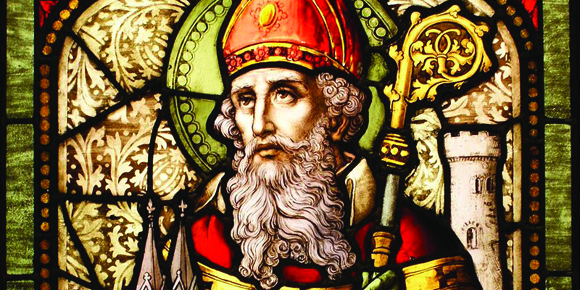Apostle to Ireland, St. Patrick (c.389-c.461), was born in Roman England. Captured by Irish pirates when he was about 16, he was enslaved in Ireland for some six years.
He escaped that existence but returned to Ireland after entering religious life.
According to Oxford’s Dictionary of Saints, the cult of St. Patrick arose upon his death. This cult has flourished ever since. Therefore, a great deal of what we “know” about this saint is fiction, not fact.
For example, a widely held story says Patrick drove the snakes out of Ireland and that’s why there are none of these reptiles on the island today. Much medieval art depicting Patrick shows him trampling snakes beneath his feet.
But the truth is, there probably never were any snakes in Ireland. At least, that’s the view of scientists.
He is also credited with confining an immense dragon to the Irish lakes “until the Day of Judgement.”
And it’s said that when he stuck his walking stick into the ground, it grew into a tree.
Another story concerns his explanation that the Holy Trinity (three persons in one God) can be likened to the three leaves on a shamrock.
Scholars have found no reference to Patrick and shamrocks even though he, himself, left many writings regarding his mission.
Easily disproved is the belief that he single-handedly converted Ireland to Christianity. Records show that conversion actually involved many evangelists and took place over several generations.
Nevertheless, he continues to be Ireland’s most popular saint. His fame was carried abroad during the great Irish Potato Famine (1845-1849) when thousands fled Ireland and settled in New World territories. The principal New York City church is named St. Patrick’s Cathedral in his honour.
Although he is Ireland’s patron saint, the first St. Patrick’s Day parade took place not in Ireland but in Boston in 1737. The now famous New York parade began only in 1762.
One extravagant celebration involves more than 45 pounds of green vegetable dye dumped annually into the Chicago River causing green water to travel the river’s course.
The colour green has been associated with both St. Patrick and Ireland from early times. Wearing green on St. Patrick’s Day was traditional by the 19th century.
In excess of five-million Canadians claim Irish ancestry, so it isn’t surprising that St. Patrick’s Day is a public holiday in Newfoundland and Labrador where it’s celebrated on the Monday nearest to March 17.
Despite the many far-fetched tales, Patrick accomplished much that was worthwhile. He traveled the length and breadth of Ireland preaching and converting despite open hostility from tribal chieftains and Druids.
During three decades of Christian evangelism in Ireland, he raised standards of knowledge, fostered the study of Latin, converted many many Irish pagans, and brought Ireland into fellowship with the rest of the western church.
It isn’t easy to visualize the Ireland of his day, but his writings show his determination to abolish paganism, sun-worship, and idolatry.
Patrick is derived from the Latin name, Patricius (patrician), a term used to describe the Roman aristocracy.



